T. rex’s skull shattering bite
The architecture of the Tyrannosaur skull was shaped by millions of years of evolution toward developing bigger jaw muscles, stronger skull bones, and increasingly thick, robust serrated teeth capable of puncturing through bone. From huge coprolites (fossil poops) packed with mulched bone, to huge shed tyrannosaur teeth lodged deeply into other dinosaur’s bones like they’d been shot into the animal with a rifle, there is a lot of evidence suggesting that T. rex had what was probably among the most powerful bites we know of from the animal kingdom, and perhaps the strongest ever among terrestrial animals. Some hard biting modern dinosaurs – parrots specifically – exhibit extensive cranial kinesis – or the ability of the bones of their skulls to flex and move. A bunch of other animals, from fish to reptiles to birds and some other dinosaurs show clear signs of cranial kinesis, so that lead Ian Cost & his team to try and figure out whether this was going on with Tyrannosaurs. In a new study, Dr. Ian Cost & colleagues test whether or not cranial kinesis was part of the suite of biomechanical adaptations that enabled T. rex to bite so bafflingly hard./>Turns out, probably not. Their computer models indicate that the numerous bones in T. rex’s head must have been tightly fused when the animal was alive, more like crocs and turtles in that regard than birds.
This new illustration was commissioned by one of the coauthors, Dr. Casey Holliday who is/was several of the other author’s PhD advisor. I gotta give an extra big shoutout to Casey for supporting his Phd student’s work even after they move on from his lab to their more permanent career positions. Not all academics are willing to invest in paleoart, especially for papers they’re not lead author on, so i really applaud his willingness to help push the scicomm for this paper with original art inspired by this new science.
I expect a few people will balk at this art either because it’s gory and/or because my T. rex reconstruction doesn’t look like all the other more slender, classically reptilian-looking tyrannosaur reconstructions people are used to, and that’s fine, I’ve been balking at all that paleoart ever since I first saw the grotesque relics of the T. rex named Sue back in 1999. Unfortunately it seems that in typical fashion for internet discourse all discussion of Tyrannosaur reconstruction has boiled down to two apparently irreconcilable sides SCALY vs. FEATHERY. I would like to make it extremely clear that I’m not on either side because I don’t see them as mutually exclusive, and honestly we don’t even know what the few sparse Tyrannosaur “scales” really are.
I encourage anyone interested in paleontology or paleo reconstruction to walk in a river bed or along a beach and look for carcasses. When you find a carcass, take a picture. Keep re-visiting it for several weeks, taking pictures each time. See how long it takes for natural deposition to bury it (or if it gets buried at all) and watch how it falls apart in the process. Studying this process is called taphonomy. If the carcass is from a bird or a mammal see what falls off first and what actually gets buried. From what I’ve seen, light weight floofy integument often detatches and blows away on the wind or floats away when water transports or begins to bury carcasses.
This simple observation has bearing on how we interpret dinosaur family trees in terms of where we might expect to see feathery structures. People seem to have no problem with the fact that mammoths and woolly rhinos frozen in permafrost – arguably the best preserved fossils of any extinct megafauna ever, and only tens of thousands of years old – have very often lost most or all of their hair.
Whooly rhino with almost no hair left…
Consider that the ONE and only highly complete large tyrannosaur fossil yet found that preserves extensive body covering is a 20 foot Yutyrannus and it’s completely floofy with feathers(and, imo still terrifying af). Now imagine how long it would take to bury a 7 ton tyrannosaur… Which begs the question what would the skin texture of a dead Tyrannosaur that all the hair-like feathers fell off of look like? Here’s what the largest living dinosaur looks like without it’s feathers:
Huge shoutout John Hutchinson. Image from his blog What’s In John’s Freezer?
Unfortunately the few skin impressions from other large Tyrannosaurs are scattered and tiny and show a texture that could be described as scaly, or that could just as well be described as deeply wrinkly. There is now evidence that the “scales” on birds scales may be derived from reduced feathers, and may likely evolved independent of crocodylian “scales” which are formed in a variety of other ways. Either way, the few tyrannosaur skin impressions looks to me (and others) much more like the tiny wrinkly scales on the legs of birds or the naked wrinkly skin on the necks and wattles of many birds, than they look like crocodilian or lepidosaurian scales.
Little hair-like feathers can sprout between the scale like structures on birds legs, and/or amidst thickened wattly wrinkle-skin. And no, I don’t buy the argument that T. rex lost their feathers because the had larger bodies. By that logic a tiger should be naked (or more naked) than a black footed cat. That’s not how biology works. So, because T. rex are much MUCH more closely related to birds than they are to crocodilians, so I did my best to reconstruct T. rex based on large carnivorous birds that have wrinkly neck skin and have few or no predators…
And that isn’t to say I think this is the ONLY way to reconstruct T. rex. I think it’s entirely plausible that they had independently evolved an integument completely devoid of even vestigial plumage. But we’ve seen that. Like, A LOT. And from where I’m standing neither the phylogenetics, nor modern analogues for those phylogenetics, nor the fossil skin impressions nor taphonomy make that the only unequivocal choice for paleoart reconstruction.
I’m sure some people will think this illustration is just another illustration glorifying predation and gore in paleoart, and on one level they’re totally right. People are compelled by violence, and me more than most. But I think there’s decent reasons to take advantage of that innate fascination with carnage. First, I think it’s important to remind ourselves how tiny and finite we are. For me at least, beholding one of the most extreme predators in earth’s history is a humbling experience, and in no small part due to the fact that my dismembered remains would fit tidily in its crop or stomach. Second, this is a study about biomechanics. Understanding the extremes of biomechanics is one of very few good reasons to study paleontology, as biomechanics have far reaching real-life applications. The biomechanics of T. rex’s jaws evolved so that they could smash the absolute shit out of things. I thus, cordially invite you to do some googles for images of animals with strong bite-forces eating. Try out search terms like “crocodiles killing zebra”, “Hyenas eating”, or “Alligator vs. turtle.” If your internet is like mine you will see ONLY HORRIFYING IMAGES. Alligators & crocs are the only living animals with bite forces approaching tyrannosaur levels of smash, and when they bite turtles the turtles literally POP. It’s fucking gross, but it’s real life.
While you’re at it check out the thickness of the necks and the gular pouches of these animals. These living animal’s skulls – even at the extreme sizes for their species – are much less massive than the skulls of a large tyrannosaurs, and only had a fraction of the ammount of jaw muscle as compared to T. rex. Also the NECK VERTS of mature T. rex are CHUNKY, have broad-based cervical ribs (which are for muscles attaching) and are often horribly gnarled with arthritis. They make the neck vertebrae of big crocodiles look almost *dainty*, and croc necks are surprisingly muscular. Also the big flat plates of bone where the neck muscles attach on the back of Tyrannosaur skulls are VAST, all of which is why my T. wrecks neck got more thickness than most reconstructions.
My work gets labeled as {overly} “speculative” a lot, and I see the word “monster” get used to refer to paleoart with teeth or blood or action in it like it’s a durogatory, but from where I’m standing it really seems like both of these labels are just ways for artists and fans of the art to try and separate things into arbitrary categories that don’t really have any bearing on how scientifically informed a piece of art is. In my view a scaly shrink-wrapped T. rex is also highly speculative. The artist just speculated that for some reason T. rex’s musculature almost didn’t exist or worked according to alternative laws of physics and that its skin covering had evolved into something not clearly suggested by the available fossils. That is a fiction, but so is every other paleoart reconstruction on some level. In mythology monsters are fictional beasts that embody ideas and values. Real data suggested by fossils informs the modern mythology of paleoart. I would argue that my art isn’t any more “speculative” or “monstrous” than images of clean T. rex’s sleeping or gently preening or whatever other cuddly Disney-fied reality people currently think is “counter to the traditional biases”. As best I can tell looking at the available evidence and the incredible fossils we have of T. rex these animals were giant stem-bird weirdos that drove their gnarled fangy smasher faces into things, propelled by stupid-thiccccc super-powerful turkey legs yanked backwards by muscles levering down most of the length of long stiffened crocodile tails. My goal was to make some art that looks like that.
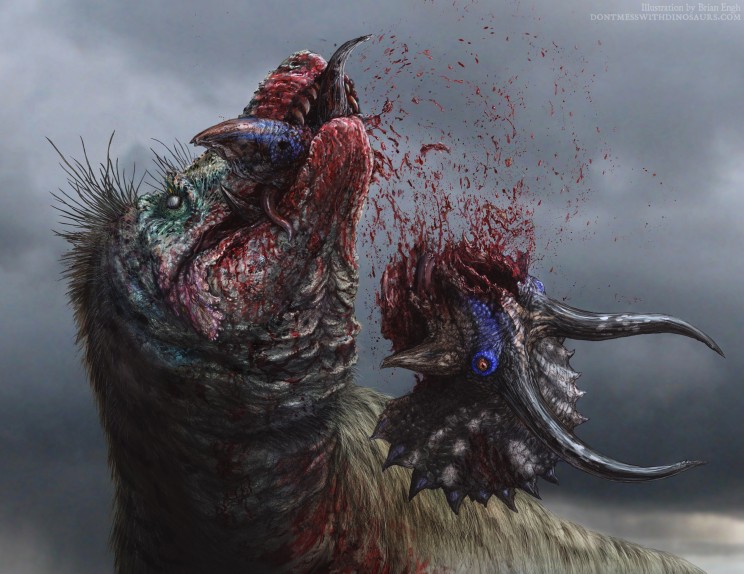
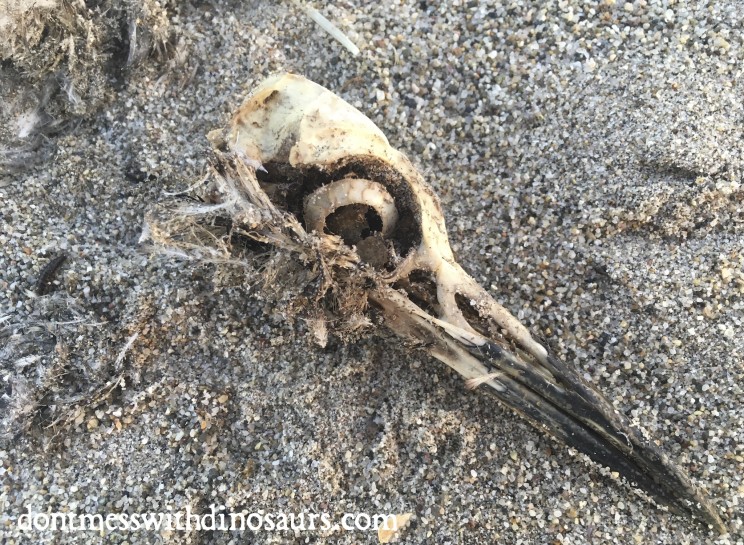
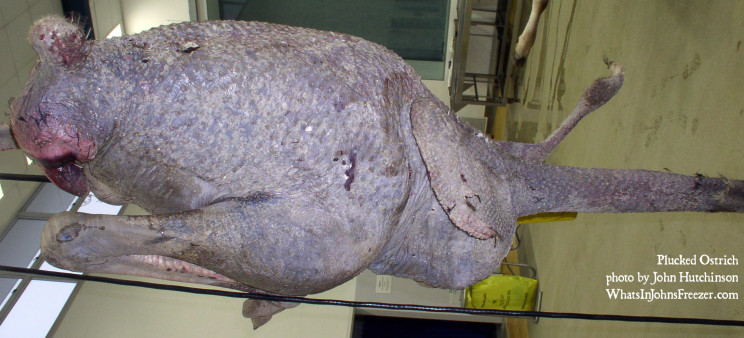
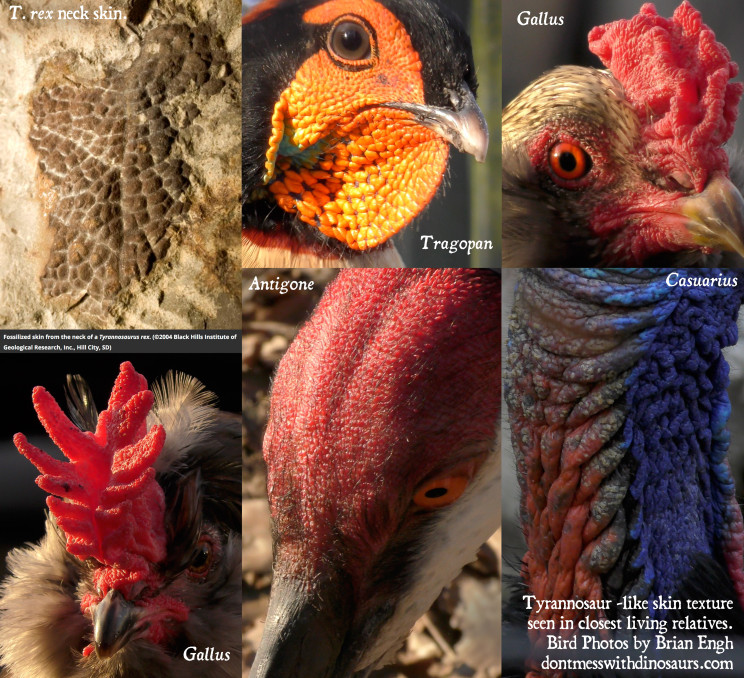
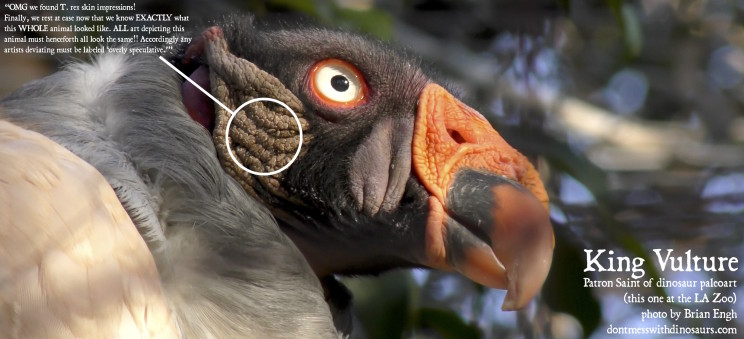
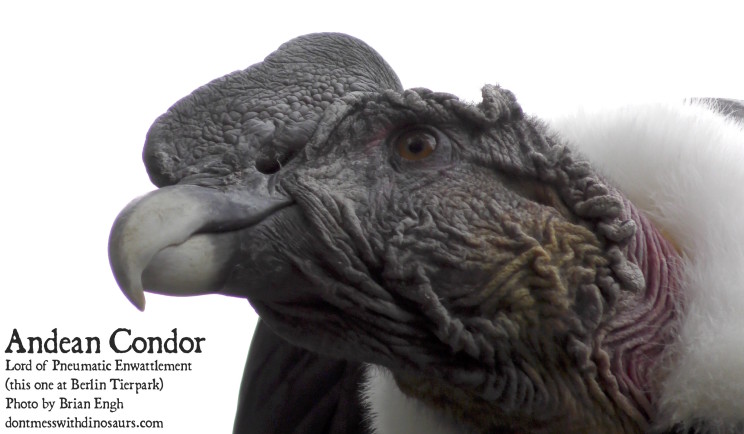
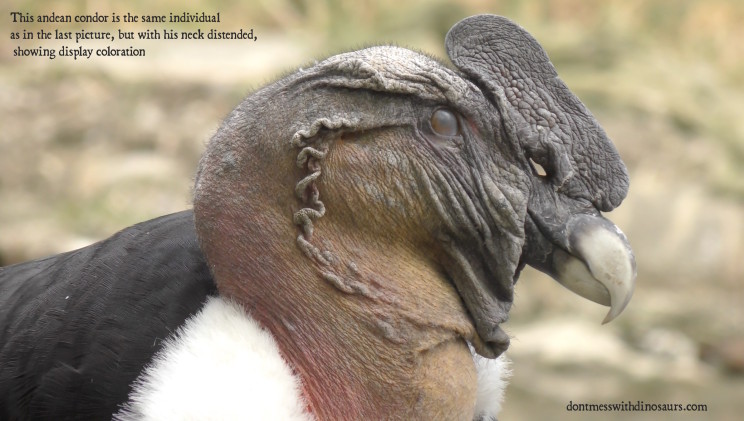
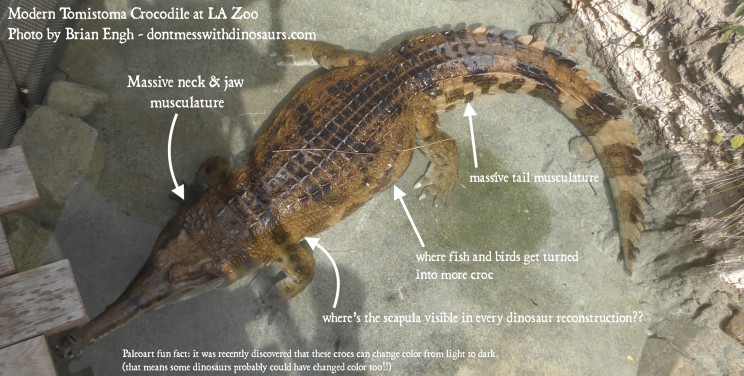
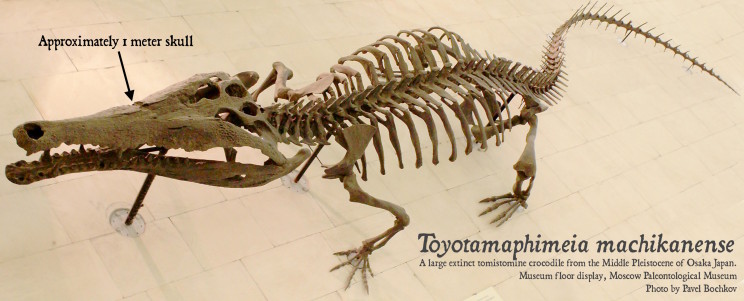

Vladimir Dinets on 25 Sep 2019 at 4:53 pm #
Brilliant artwork. I’m so tired of dinosaurs being imaged as if they are groomed and shampooed poodles.
Reality on 25 Sep 2019 at 6:35 pm #
“BUT we KNOW T. REKZsz were ScÄlY!!” I can just hear their cracking voices skronking at their computer screens from somewhere in the cheeto and mountain dew-stained depths of their parent’s house. To them I say, please, go walk in a river bed or along a beach and look for carcasses. When you find a carcass, take a picture. Keep re-visiting it for several weeks, taking pictures each time. See how long it takes for natural deposition to bury it (or if it gets buried at all) and watch how it falls apart in the process. Studying this process is called taphonomy. It’s one of the few fields that smells worse than your gaming chair. If the carcass is from a bird or a mammal see what falls off first (Spoiler alert: It will almost always be the hair or feathers).
Except that the inside rottens first? Someone needs to revisit the biology courses. And maybe read Saittal_et_al-2018-Experimental_Subaqueous_Burial_of_Bird_Carcass_and_Compaction_of_Plumage
And maybe take some course in development of feathers and how phylogenetic should be applied.
Jeff Martz on 25 Sep 2019 at 9:21 pm #
Also, check out photos of owl feet. It is possible for skin to be scaled _and_ have feather sprouting between the scales, and one wonders if decomposition and preservation could preserve one but not the other. You make a good point that skin shape doesn’t necessarily tall you what kind of structure is making the shape, especially with skin impressions that are on the crude side.
Historian on 25 Sep 2019 at 11:55 pm #
Ah yeah I had mentioned owls in an earlier draft of this post but I guess that got chopped out at some point. But yes, for sure. Even chickens and pigeons will sometimes sprout feathers from between the scales on their legs.
To the other guy who commented about feather compaction: you need a lagerstatte or rapid fine sediment deposition to preserve plumage around a whole animal. So far at least, that is not the kind of environment we find T. rex or the other super sized derived tyrannosaurs. They’re usually buried in layered mudstones and sandstones by rivers.
And animals buried by and/or transported by rivers often bloat as their innards break down, but often shed integument before they actually burst. Check out all the various “chupacabras”, “Montauk Monster” etc = all regular everyday common animals like dogs and cats and raccoons that have bloated and shed their integument well before being buried or even losing their guts.
https://en.wikipedia.org/wiki/Montauk_Monster
https://doubtfulnews.com/2012/07/first-hairless-bloated-dead-monster-of-the-season-found-along-nys-east-river/
John on 26 Sep 2019 at 1:08 am #
It’s really funny to how some people try to sound superior to “awesomebros” or whatever name you prefer it, by at the end they sound just as entitled and whiny as then.
Not funny tho, it’s kinda sad. This is science, not a sport. Stop trying to compete to see who’s more immature.
Vlad on 26 Sep 2019 at 4:22 am #
As a long-time ‘armchair paleontologist’ who has often pooh-poohed the “feathered TRex” theory by pointing out that there is no evidence of anything other than TRex scales (YET), I must say I read your blog with a smile of amusement and a chuckle.
I thoroughly enjoyed your ‘in your face’ style (as befits someone passionate about the subject he is discussing), and no, I did not find the art too gross (other than asking – could a TRex REALLY snap the front half of the /face off of a LIVING Triceratops??? – scary sh*t there – but from what we know of the TRex bite force…if ANY animal ever could do such a thing, well, TRex would be that animal! I reiterate, its a SCARY illustration, because its the first one I’ve seen that appears to capture what we now know about the POWER of this animal’s jaws – Just visualize a juicy, non-armored human in its path … but I digress).
To the point.- after reading your post, I am actually now open to the idea of a fully feathered TRex – (I think the King Vulture photo did it- good show). In fact, if I may dare say, I am now actively HOPING we find some feathered TRex skin impressions. Because, well, it would make the Tyrant King even MORE COOL (if that was possible!) And besides … that would give us a whole new set of TRex model kits and toy figures … and who could ever be opposed to THAT? ;>)
Cheers – and Good work!!
Reality on 26 Sep 2019 at 7:00 am #
Jeff Martz Feathers and scales are mutually exclusive they emerge from the same embryonic placode thanks to different hormones, and go from there.
When the hormone for feathers is present, scales cannot form. It takes some complicated developmental tricks to stunt feathers into the scutes and reticulae we see on bird feet, and even then those bits have to come first thanks to how feathers develop. wich is a very complicated process. This is an invention made by Neornithes.
https://www.ncbi.nlm.nih.gov/pmc/articles/PMC2736124/
Historian: Th plumage ornithomimid is found in a high energy deposit same as other advanced Tyrannosaurids? That Ornithomimus was found in sandstone, is a big deal because it shows that these soft tissues may be more resilient than we first thought.
https://www.sciencedirect.com/science/article/pii/S0195667115300847
As for decomposition, insides rot before outsides even fine keratin structures last longer than almost anything else in the body besides bones.
That’s why carcasses bloat: bacteria feeding on liquified internal organs produce gasses. Skin, which is much more rot resistant (natch, since that’s it’s job: protect the squishy stuff) lasts long enough to retain those gasses, at least until the buildup causes a catastrophic release.
I would suggest listen in to Witmers former student paleontologist Dr.Jason Bourke who explains well how development of feathers actually works based on scientific studies starts around he touch up on this specific subject 36:30 https://youtu.be/I_KctJGG9RU
Historian on 26 Sep 2019 at 11:35 pm #
To anyone who isn’t just laughing at the tone of this blog post, please understand that I wrote it that way mostly to make people who have dealt with angry paleo nerds online laugh. I have no desire to look more mature than them or whatever, that would be a silly goal considering most of them actually have useful jobs that the world needs, while I, somehow, am basically a professional 8 year old with some artistic proficiency. That said, please understand that as a professional artist who has specialized in natural history art I take a lot of weird condescending flack for things that are far from certain. I got into this art because I love the uncertainty and uneasiness the vastness of deep time makes me feel, and I embrace the reality that all paleoart is presenting a hypothesis at best, and most all of it becomes inaccurate over time. What strikes me as weird is that even when as an artist you go to great lengths to politely communicate the science and inference behind your art people (usually just on the internet) tend to take a tone with paleoartists that is amazingly confident and often downright rude. There are definitely times when my sense of humor or personality or general tactlessness on the internet probably brings that out of people, but I know it happens to a lot of other artists too, many of which are some of the nicest & gentlest people I know. The tone of my blog is for them more than anybody. On a few occasions I’ve spoken out about the rudeness paleoaritsts receive and I’ve had a lot of artists come forward and tell me they either quit paleoart or took a big step back from it because of things people said about their art. The tone of this blog post was almost an attempt to preempt that, but mostly a way to toss out some darts to blow off a little steam for laughs. I need to up my comedy game if people think I actually take myself seriously (like, at all).
To the Reality guy: ah I’d forgotten about the ornithomimid feathers. I still want to see that specimen. The point I was trying (and apparently failing) to make is that a lot of feathers/hairs slough off of carcasses that are exposed to weathering or water transport for any length of time. Check them carcasses I posted above. I’ve seen stuff like that myself on numerous ocassions, and I think the bloating may even assist with the hair sloughing because the carcass will float and roll around for a while before it gets buried.
LeeB on 27 Sep 2019 at 2:00 am #
Having seen the alligator versus turtle videos it makes you wonder what a Purussaurus versus a Stupendemys must have looked like.
Purussaurus skulls are really heavily built.
Historian on 28 Sep 2019 at 8:55 am #
Just commenting to note that I edited this post from it’s original version to include less roasting of rude paleoart critics that me and my fellow paleoartists have to deal with every time we put out new work. I initially included those jabs because they made me chuckle when i was writing them, and i thought they’d make my fellow paleoartists and a few paleontologists giggle, but that’s writing for an audience of about 5 people which is a pretty narrow audience :}}
I genuinely want to see the discourse in the paleo community improve and I’m trying to learn that my dumb sense of humor generally doesn’t work in a text-based online format.
Anyway, i love yall, even if you are an grumpy internet user who for some reason is super confident they know way more about how nature works than experts who have studied this stuff for years and who tend to readily admit we know incredibly little.
Amy Acquafondata on 04 Oct 2019 at 12:04 am #
I am just another armchair paleontology fan, some one maybe a little too old and without the money to go back to school right now. I just wanted to say it is correct that too many people nitpick paleo artists for what they do. I have absolutely no artistic or musical ability, but my sisters do, and it is very hard to get paid to do that for a living. When Luis Rey first came out with that vulture looking velociraptor, so many people complained it was a little shameful. Scott Hartman spent a whole blog defending cheeks and lips. He didn’t have to justify his decisions, but he felt maybe we could all learn something. I for one am grateful when artists explain some of the science behind their art, because I learn so much more from that, especially when the arguments include references I can look up later. It is different when artists just make up stuff, than when you work with scientists to try to create something as close to real as possible. Obviously, Tyrannosaurs had huge neck and jaw muscles, so those skeletal like dinosaurs from Dinosaur Revolution were fun, but maybe a little artistic than realistic. So I prefer an ugly nasty fat tyrannosaur if that was truly more accurate. Remember that triceratops skull that had its head pried off the body at the ball joint. Sorry I’d have to take too long to go back and find the proper name for the joint. Just do what you do and enjoy it. Your art is fine by most of us. I appreciate you try to be accurate, and are not too condescending to explain things to you readers. thank you very much for your time, and sharing your art.
Francois on 21 Sep 2020 at 9:25 am #
Fantastic reading! Good enough to read it again and again. I noticed you gave your Dilo big spiky quill feathers behind it’s weird head and crest. Although it’s cool to give the big Early Jurassic theropod feathers, but most birds with big noticeable crests like the cassowary and the Helmeted Guinea-fowl usually don’t mix feathers and crests because then the crests would be less visible. I’m not judging or criticizing your restoration of the animal, I hope it’s okay if I share my honest thoughts about your restoration of the theropod. I honestly love your work and you make these incredibly extinct animals come back to life in your paleoart. I’m no paleoartist, but I look at a certain dinosaur fossil or mounted skeleton online, then I look at modern birds and reptiles and try to recreate the extinct animal in my mind what it would look like in life. Sadly, I hardly get time to work on my drawing as I loved it as a kid. My favorite dinosaurs are the ones who are most mysterious to science like Spinosaurus and Dilophosaurus. Although I will never be able to see the actual site or the mounted recreation of Dilophosaurus when it’s finished, I can’t wait to see it online and I hope more amazing discoveries are made in the near future. Definitively don’t mess with dinosaurs.